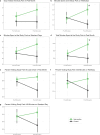Park use patterns and park satisfaction before and after citywide park renovations in low-income New York City neighborhoods
- PMID: 40596329
- PMCID: PMC12217957
- DOI: 10.1038/s41598-025-07264-3
Park use patterns and park satisfaction before and after citywide park renovations in low-income New York City neighborhoods
Abstract
Urban parks may promote health through physical activity, stress management, and social connectedness. However, poor-quality parks in disrepair are underutilized, limiting these benefits. This study evaluated the impact of a citywide park renovation program known as the Community Parks Initiative (CPI) on changes in park use patterns and park satisfaction among residents living in low-income New York City neighborhoods. Repeated cross-sectional surveys were administered to residents living near 31 parks undergoing CPI renovations (545 pre-renovation and 201 post-renovation respondents) and near 21 parks in socio-demographically matched control neighborhoods (345 pre-renovation and 129 post-renovation respondents). Surveys measured self-reported past-month park visits, typical park visit duration, and satisfaction with park quality and facilities. Using a difference-in-differences (DID) approach, generalized estimating equations were fit to compare changes over time in park use and satisfaction among residents living near parks receiving renovations compared to those living near control parks. Models were adjusted for age, body mass index, income, public housing, marital status, and children in household. Residents in neighborhoods receiving park renovations reported a larger increase in minutes spent at the park on weekdays [DID = 30.0 min (95% CI 10.3, 49.7)] and total minutes spent at the park in the last 30 days [DID = 466.3 min (95% CI 63.0, 869.6)] compared to controls. Residents of renovated park neighborhoods also reported larger increases in park satisfaction relative to residents of control neighborhoods, with the largest improvements in the percent of residents satisfied with overall park quality [DID = 38.4% (95% CI 25.2, 51.6)] and maintenance of grounds and facilities [DID = 40.9% (95% CI 27.7, 54.1)]. This study provides evidence that park renovations are an important urban planning strategy to support community health through increased park use and improved park perceptions.
Keywords: Built environment; Natural experiment; Park renovation; Park satisfaction; Park use; Urban health.
© 2025. The Author(s).
Conflict of interest statement
Declarations. Competing interests: The authors declare no competing interests. Ethical approval: This study involved the use of human subjects. All procedures were performed in compliance with relevant laws and institutional guidelines and were approved by the appropriate institutional committees (City University of New York Institutional Review Board approval #2016-0248). The privacy rights of human subjects were observed and written informed consent was obtained from all participants prior to participation in research activities.
Figures


References
-
- Ritchie, H., Samborska, V. & Roser, M. Urbanization. Our World in Datahttps://ourworldindata.org/urbanization (2024).
-
- World Health Organization. Urban health. https://www.who.int/news-room/fact-sheets/detail/urban-health (2021).
-
- Ventriglio, A., Torales, J., Castaldelli-Maia, J. M., Berardis, D. D. & Bhugra, D. Urbanization and emerging mental health issues. CNS Spectr.26, 43–50 (2021). - PubMed
-
- Escobedo, F. J., Kroeger, T. & Wagner, J. E. Urban forests and pollution mitigation: Analyzing ecosystem services and disservices. Environ. Pollut.159, 2078–2087 (2011). - PubMed
-
- Nowak, D. J., Crane, D. E. & Stevens, J. C. Air pollution removal by urban trees and shrubs in the United States. Urban For. Urban Green.4, 115–123 (2006).
MeSH terms
Grants and funding
LinkOut - more resources
Full Text Sources
Miscellaneous

